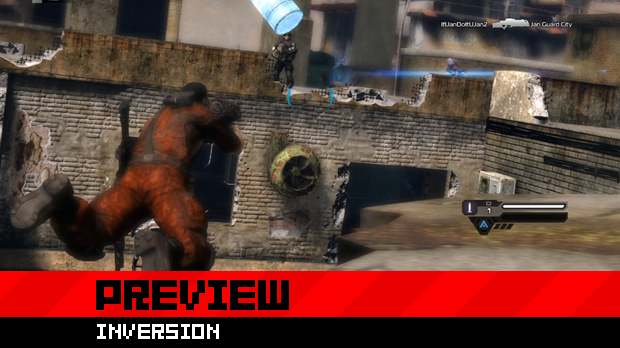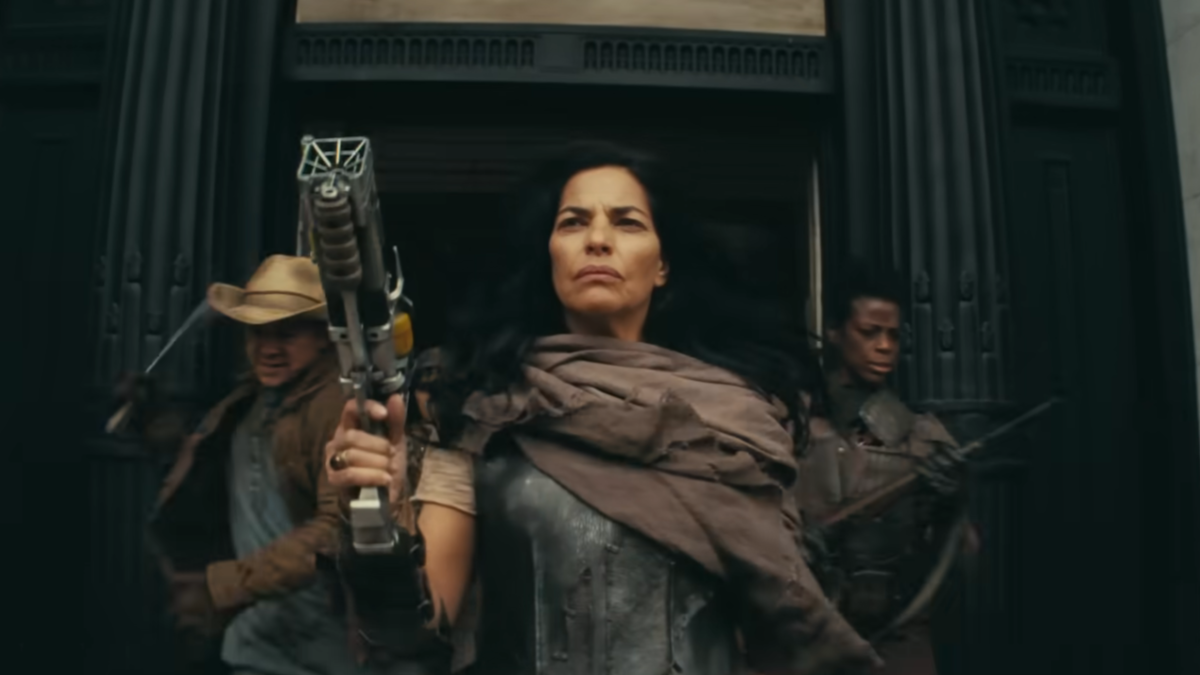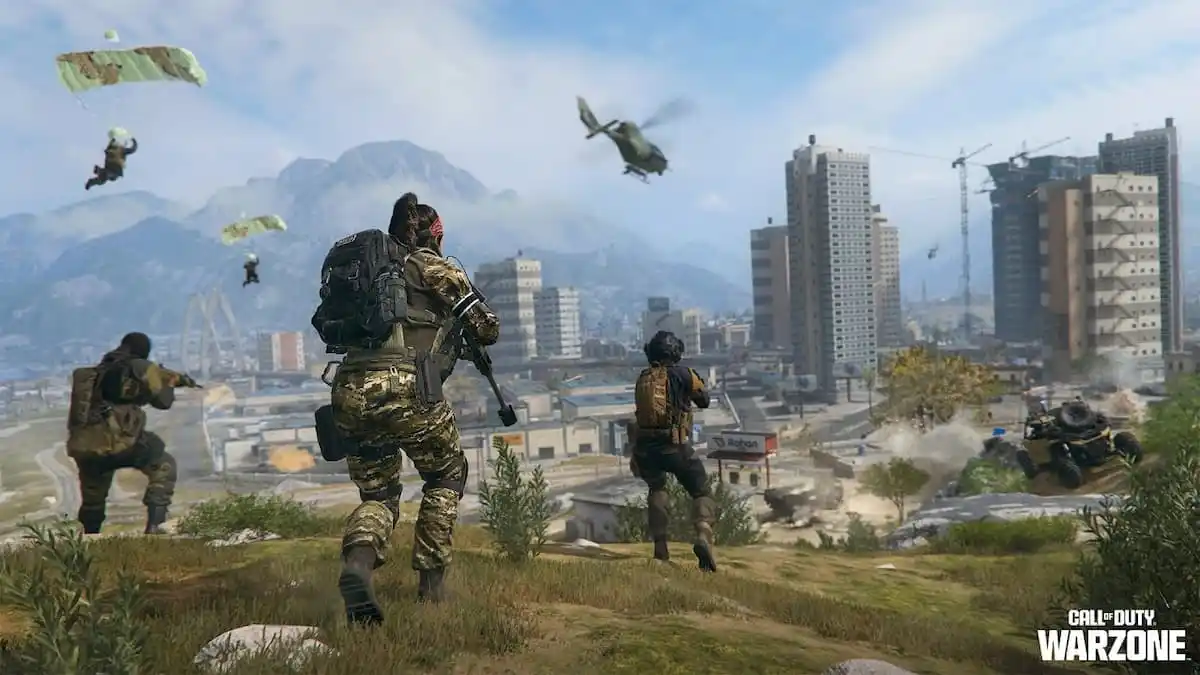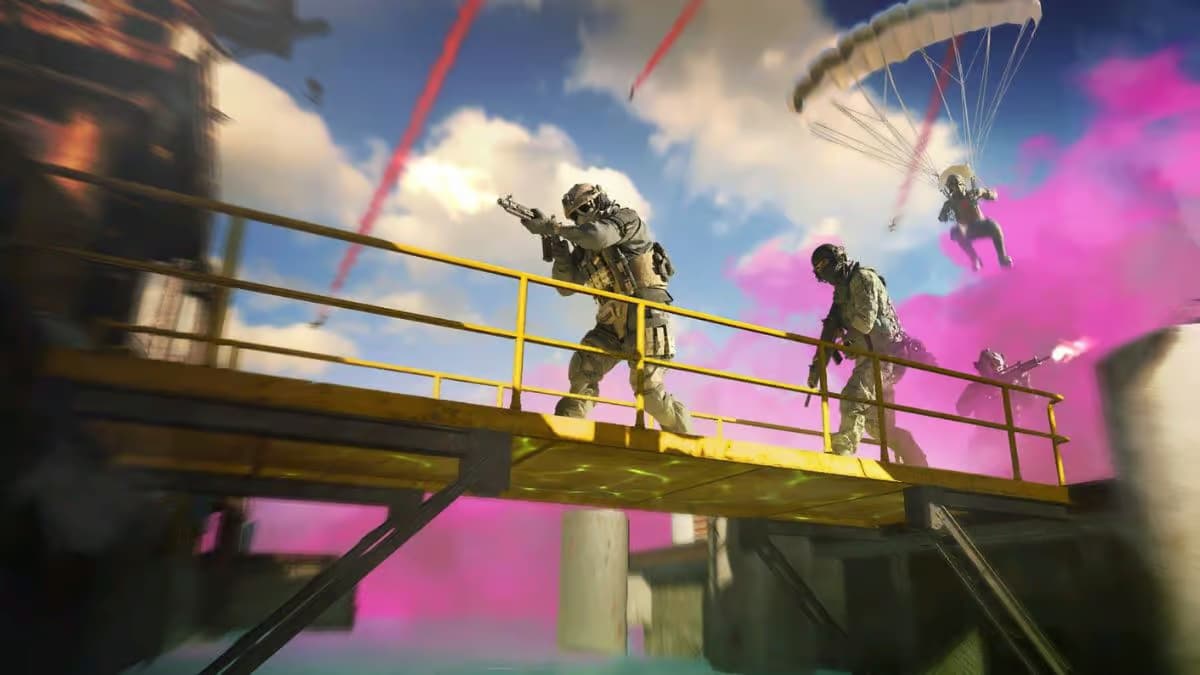Last month, Maurice Tan brought us a preview of the co-op campaign that can be found in Inversion. Generally speaking, he summed up the gameplay to be a sort of Gears of War clone with light gravity manipulation. One really cannot argue against these points as in my multiplayer preview, I definitely saw the strong Gears of War influence (bulky men tromping around environments with big guns, enemies that drill out of the ground, etc.) and a lot of the actual gravity shifting that took place bordered on linear.
However, the gravity manipulation power that your own character possesses is the key to what makes the multiplayer portion of the game its own beast, and in some ways this “gimmick” may add something to a genre that’s starting to look a little tired.
Inversion (PC, Xbox 360, PlayStation 3)
Developer: Saber Interactive
Publisher: Namco Bandai
Release date: February 7, 2012
After a brief rundown of the vaguest elements of the single-player campaign (Two cops undergo personal tragedy when creatures kill/kidnap people close to them, now they must find out source of creature origin and take revenge, rinse and repeat), we were launched into the first of three multiplayer modes — a free-for-all, 16-player Deathmatch mode on a map simply called Plaza.
The multiplayer map in Plaza immediately resembled maps from certain other games, so those of us in attendance knew more or less what to expect. The biggest difference between this map and others like it were the bits of rock and other debris just floating around in the dead center of the map, which allowed for players to jump in zero gravity from rock to debris and then on to the other side of the map. The competitive advantage of this was immediately obvious, as it allowed players to quickly shortcut from one well-covered section of the map to the other and quickly regain cover away from or near enemies.

The biggest drawback of this area was that it left the player more exposed to gunfire from pretty much anywhere except right in front of them. Gameplay-wise, it does add an interesting wrinkle as it could potentially help a player gain an advantage with some quick thinking while in the midst of a firefight. It’s also amusing to watch other players go floating across the map only to be gunned down and then drift away as a lifeless corpse.
Overall, this particular example of gravity manipulation left a little to be desired as you couldn’t just float anywhere you wanted à la Dead Space 2 and so players are limited to taking exact routes to shortcut across the map. In a competitive arena, I can see how this sort of linearity make sense as I’ve seen plenty of gamers take advantage of extra freedom to find ways to glitch out and generally be cheap, but if the developers give you the freedom to float about you’d expect it to be a little more…well, free.
Much of the control was also liberally “borrowed” from other similar games, though this actually helped to make everything feel familiar and comfortable. The biggest difference here came in the form of the player’s own gravity manipulation powers. This is also where the gameplay gets interesting and dare I say it — even quite fun.
In classic Deathmatch mode, the player is given two gravity powers that are used with a press of the right bumper and switched by clicking the right analog stick. The first one allows you to peg other players with a sphere of high gravity, in effect pinning them to the ground and making them extra vulnerable to your attacks. You know that you are using this power because an attachment on the back of your shoulder strap acts as an indicator and glows red when the high gravity power is equipped and the sphere that surrounds your enemies is also red.
Conversely, this attachment glows blue when you equip low gravity, which throws enemies into the air in a blue sphere to dangle helplessly as you pump them with bullets. While enemies are in this vulnerable state, they are still able to pivot around to shoot at you and to “shift” to the left or right to dodge bullets and projectiles.

I found using these weapons both immensely satisfying and helpful to gain a competitive edge on the battlefield. One of the other journalists I was competing against seemed to keep seeking me out and getting in cheap kills until I got the hang of the high-gravity power and doled out revenge by pinning him to the ground and dropping a grenade next to his face before leaping off into the center of the map where he was unable to shoot me. Scenarios like this cropped up with relative frequency and at times were quite amusing, such as when I watched two players pin each other to the ground with high gravity and ran by them guns blazing, effortlessly taking both down.
With low gravity enabled, you could also grab objects and throw them or use them for cover. I experimented a couple times by grabbing barrels and tossing them across the map, though the only hit I got in bounced uselessly off of the player I was aiming for and instead simply alerted him to my presence so that he could easily mow me down.
When the Deathmatch mode got especially hectic, my game became incredibly laggy. It started off with just a stutter here and there but after a few minutes I might as well have been playing the game through a flipbook filter, as my character lost several moments of animation with every minute that passed. When I looked around, I noticed that about half of the other players were experiencing lag that ranged from moderate to severe while the other half kept right on playing with silky smooth frame rates (at minimum 30 fps).
The representatives who were there noticed our concerns and assured us that the developers were still hard at work on this issue. The build we saw is still pretty early — the game won’t be released until February of next year, and one can only hope that Namco holds true to its promise and really cleans up these frame rate issues, as the game will be a nightmare for some if they experience the sort of lag we were seeing in Deathmatch.
After I did fairly well in Deathmatch despite the aforementioned problems, our group of journalists were introduced to the next mode, called Hourglass, that was a Team Capture the Flag mode within a huge Satellite drifting in space. (The map was called Satellite, of course.)
Each team was given only one of the two gravity manipulation powers, and I was quite happy to be paired up with the high-gravity power again. Interestingly, my character and the other characters on my team seemed to have at least a passing resemblance to a character from another team-based shooter.

The biggest twist to the formula presented in this map revolved around the actual capturing the flag. Every time either team captures the opposing team’s flag, the entire center of gravity is switched from the floor to the ceiling, and there are always a few moments between switches where everyone on the map is floating freely in space. While this was a pretty cool effect to witness and sort of fun to get kills in between each shift, the actual layout of the map itself didn’t seem to have any severely noticeable changes besides the switch from attacker to defender and vice versa. Many of the same areas of cover and other constructs found on one plane of battle often seemed to exist somewhere nearby on the other as well.
This concept could certainly be exploited more beyond what we were shown. I would hope for maps that would shift the center of gravity to walls as well, with things like breakable windows that would jettison hapless players into space, or other novel ideas added to this concept of gravity shifting. By itself, the shift is a neat thing to witness but it is also not much more than a gimmick.
While the gameplay in these sections was certainly fun and challenging, beyond the gravity shift between each flag capture and the player gravity manipulation there was absolutely nothing else that hasn’t already been done to death a million times before. If Namco Bandai is able to inject some interesting added twists to the gravity shift idea, it could potentially be an awesome time.

Finally, the last map we were shown involved a four-player cooperative campaign of sorts. The mode was called Survival and it resembled Gears of War‘s Horde mode in that your team was constantly fighting against an ever-stronger barrage of incoming enemies.
The biggest difference was that your team started on one section of the map and continued to fight their way through different areas, gaining checkpoints along the way. The entire map was called Boulevard, and it started out in a building overlooking a street of some random metropolitan area as enemies came in from somewhere down the street. In this mode, the players can only wield gravity manipulation powers and weapons besides the default assault rifle by finding pickups within the map. The more kills that team members were able to get, the more time the whole team was allotted for getting through a given section of the entire map. This made for frantic gameplay as we blasted through the enemy assault and then ran to get to an elevator that would take us to the next section.
Enemies ranged from grunts with basic armor to bigger grunts with heavy shields and dudes that drilled up from the ground to armored vehicles that took a lot of damage before being destroyed. After making our way through most of the map, we were finally faced with a boss battle of sorts inside of a parking garage against a mechanized killing machine called the Butcher. Though this enemy took a lot of firepower to take down, it seemed like there was still work to be done to make the battle a bit more interesting, as the best strategy seemed to be to either A) find a piece of cover that the Butcher just couldn’t get to because of its size and then proceed to take potshots, or B) simply run at the mechanized monster and shoot at it until it died.

Overall, I think that Inversion and its gravity-shifting mechanism shows some promise, as the multiplayer portion of the game had some novel concepts and fun and hectic gameplay. With a little tweaking of the frame rate and a few other missing elements added to the gravity concept, Inversion may be a fun, interesting multiplayer experience that stands on its own.
Only time will tell before we’ll know whether Namco Bandai has a single-player campaign that contributes to the experience as a whole. For now, the multiplayer portion of the game seems to be coming along with a few good ideas that simply need to be implemented well.




